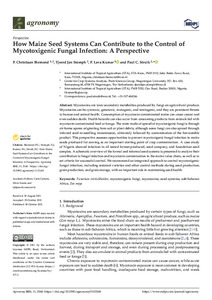| dc.contributor.author | Biemond, P.C. |
| dc.contributor.author | Stomph, T.J. |
| dc.contributor.author | Kumar, P.L. |
| dc.contributor.author | Struik, P.C. |
| dc.date.accessioned | 2021-11-15T11:16:57Z |
| dc.date.available | 2021-11-15T11:16:57Z |
| dc.date.issued | 2021 |
| dc.identifier.citation | Biemond, P.C., Stomph, T.J., Kumar, P.L. & Struik, P.C. (2021). How maize seed systems can contribute to the control of mycotoxigenic fungal infection: a perspective. Agronomy, 11(11), 2168: 1-13. |
| dc.identifier.issn | 2073-4395 |
| dc.identifier.uri | https://hdl.handle.net/20.500.12478/7283 |
| dc.description.abstract | Mycotoxins are toxic secondary metabolites produced by fungi on agricultural produce. Mycotoxins can be cytotoxic, genotoxic, mutagenic, and teratogenic, and they are persistent threats to human and animal health. Consumption of mycotoxin-contaminated maize can cause cancer and even sudden death. Health hazards can also occur from consuming products from animals fed with mycotoxin-contaminated feed or forage. The main mode of spread of mycotoxigenic fungi is through air-borne spores originating from soil or plant debris, although some fungi can also spread through infected seed-to-seedling transmission, ultimately followed by contamination of the harvestable product. This perspective assesses opportunities to prevent mycotoxigenic fungal infection in maize seeds produced for sowing as an important starting point of crop contamination. A case study of Nigeria showed infection in all tested farmer-produced, seed company, and foundation seed samples. A schematic overview of the formal and informal seed systems is presented to analyze their contribution to fungal infection and mycotoxin contamination in the maize value chain, as well as to set criteria for successful control. We recommend an integrated approach to control mycotoxigenic fungal infection, including resistant varieties and other control methods during seed production, grain production, and grain storage, with an important role in maintaining seed health. |
| dc.format.extent | 1-13 |
| dc.language.iso | en |
| dc.subject | Fusarium |
| dc.subject | Fungi |
| dc.subject | Mycotoxins |
| dc.subject | Seed Systems |
| dc.subject | Subsaharan Africa |
| dc.subject | Maize |
| dc.subject | Zea Mays |
| dc.title | How maize seed systems can contribute to the control of mycotoxigenic fungal infection: a perspective |
| dc.type | Journal Article |
| cg.contributor.crp | Maize |
| cg.contributor.crp | Roots, Tubers and Bananas |
| cg.contributor.affiliation | International Institute of Tropical Agriculture |
| cg.contributor.affiliation | Wageningen University and Research Centre |
| cg.coverage.region | Africa |
| cg.coverage.region | West Africa |
| cg.coverage.country | Nigeria |
| cg.coverage.hub | Headquarters and Western Africa Hub |
| cg.researchtheme | Plant Production and Health |
| cg.identifier.bibtexciteid | BIEMOND:2021 |
| cg.isijournal | ISI Journal |
| cg.authorship.types | CGIAR and advanced research institute |
| cg.iitasubject | Agronomy |
| cg.iitasubject | Food Security |
| cg.iitasubject | Maize |
| cg.iitasubject | Plant Breeding |
| cg.iitasubject | Plant Diseases |
| cg.iitasubject | Plant Health |
| cg.iitasubject | Plant Production |
| cg.journal | Agronomy |
| cg.notes | Open Access Journal; Published online: 28 Oct 2021 |
| cg.accessibilitystatus | Open Access |
| cg.reviewstatus | Peer Review |
| cg.usagerightslicense | Creative Commons Attribution 4.0 (CC BY 0.0) |
| cg.targetaudience | Scientists |
| cg.identifier.doi | https://dx.doi.org/10.3390/agronomy11112168 |
| cg.iitaauthor.identifier | P. Lava Kumar: 0000-0003-4388-6510 |
| cg.futureupdate.required | No |
| cg.identifier.issue | 11: 2168 |
| cg.identifier.volume | 11 |

